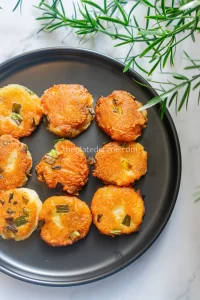When it comes to Indonesian cuisine, few dishes are as universally loved and versatile as perkedel kentang. These golden, crispy potato fritters are a staple side dish, served alongside everything from soto (Indonesian soup) to nasi kuning (yellow rice) or even enjoyed as a snack. Easy to prepare and endlessly customizable, perkedel kentang is a dish that appeals to all ages and occasions.
Table of Contents
So, what makes perkedel kentang so special? The magic lies in its simplicity and the perfect balance of texture and flavor. With a soft, creamy interior encased in a lightly crispy shell, perkedel kentang offers a comforting bite that feels like home. However, achieving that perfection requires a bit of know-how. From choosing the right type of potato to mastering the frying process and seasoning techniques, this guide will walk you through every step to create the perfect perkedel kentang.
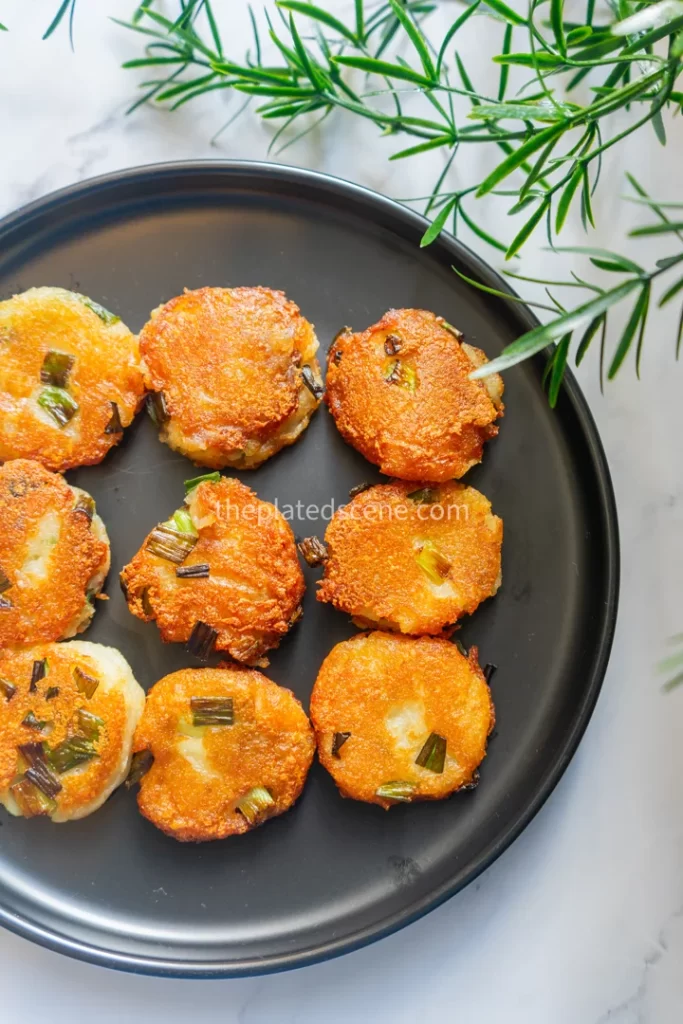
What is Perkedel Kentang?
Perkedel kentang translates directly to “potato fritters,” with “perkedel” referring to the fritter and “kentang” meaning potato. While perkedel has its roots in Dutch frikadellen (meat patties), the Indonesian version has evolved to highlight mashed potatoes as the star ingredient, often enhanced with spices, aromatics, and sometimes protein like minced meat or fish. The result is a dish rich in flavor yet simple in preparation.
Choosing the Best Potatoes for Perkedel Kentang
The key to achieving the right texture for perkedel kentang is selecting the right potato type. Starchy potatoes like Russet or Yukon Gold are the best choice because they are easy to mash and hold their shape during frying. These potatoes have a low moisture content, which prevents the mixture from becoming too wet or soggy.
Avoid waxy potatoes like red or new potatoes, which have higher moisture levels and can result in perkedel kentang that falls apart during frying. If you only have waxy potatoes, consider frying or roasting them first to reduce the moisture content.
Why Fry the Potatoes Instead of Boiling?
Traditional recipes for perkedel kentang recommend frying the potatoes before mashing them, and for good reason:
- Improved Texture: Frying the potatoes removes excess moisture, ensuring a firmer mixture that holds its shape when formed into patties.
- Enhanced Flavor: The Maillard reaction that occurs during frying gives the potatoes a richer, caramelized taste, elevating the overall flavor of the perkedel kentang.
- Avoiding Sogginess: Boiling potatoes can retain water, making the mixture too wet and difficult to work with.
Roasting the potatoes is an excellent alternative if you prefer a lighter method. Bake them at 200°C (400°F) until golden and tender.
Perfect Seasoning for Perkedel Kentang
The flavor of perkedel kentang is defined by its seasoning. While traditional recipes often include garlic, nutmeg, and white pepper, modern variations allow creativity. For a savory and aromatic profile, consider these ingredients:
- Blended Garlic and Shallots: These create a robust base flavor that pairs perfectly with the creamy potatoes.
- Mushroom Stock: A vegan-friendly alternative that adds a deep umami flavor.
- Green Onions: Chopped green onions add a touch of freshness and a hint of sharpness to balance the richness.
Adjust the seasoning to taste before forming the patties. A well-seasoned potato mixture is the foundation of a delicious perkedel kentang.
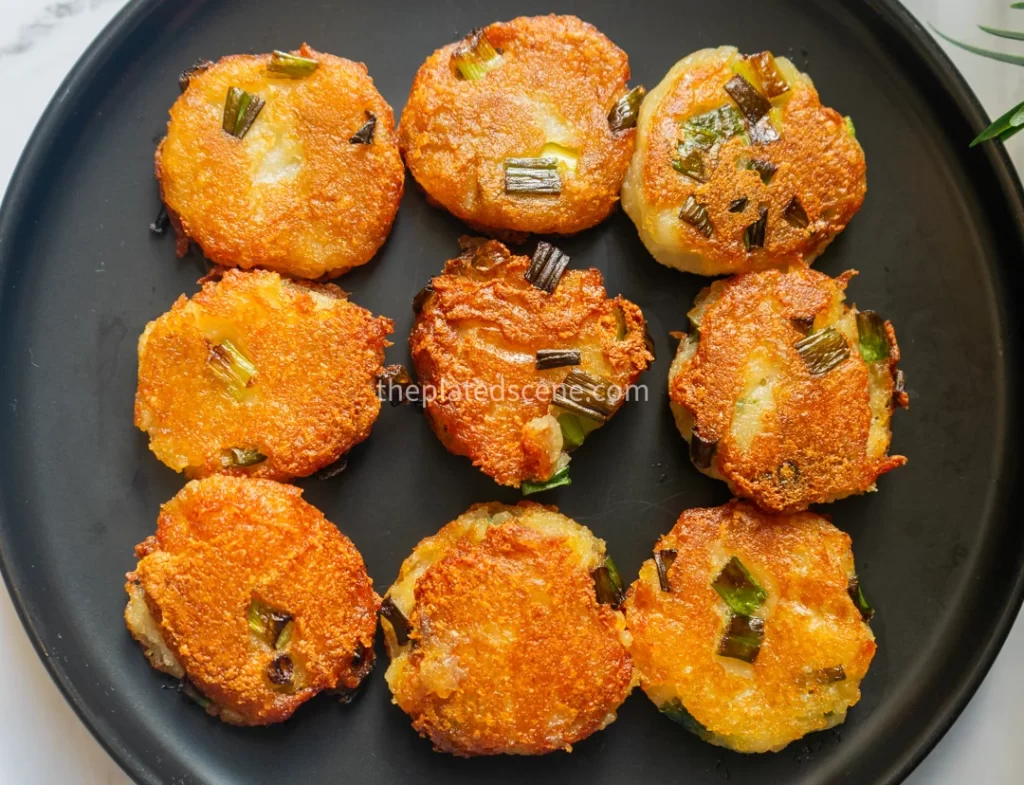
How to Make Vegan Perkedel Kentang (Without Eggs)
Eggs are commonly used in perkedel kentang as a binding agent and coating to ensure a smooth fry. However, you can easily make a vegan version by substituting the egg with plant-based alternatives. Here’s how:
- Use a Binding Agent: Replace the egg with cornstarch, all-purpose flour, or flaxseed and water mixture (1 tablespoon flaxseed + 2.5 tablespoons).
- Chill the Mixture: Refrigerate the shaped patties for 30 minutes before frying. This helps them hold their shape during cooking.
- Handle with Care: Use a spatula to gently place and flip the patties in the pan to prevent them from breaking apart.
Tips to Prevent Perkedel Kentang from Sticking to the Pan
One of the common challenges when frying perkedel kentang is preventing them from sticking to the pan. Here’s how to avoid that:
- Preheat the Oil: Ensure the oil is hot enough before adding the patties. Test by dropping a tiny breadcrumb into the oil; if it sizzles immediately, the oil is ready.
- Use a Non-Stick Pan: Fry the patties in a non-stick pan or a well-seasoned cast-iron skillet for best results.
- Don’t Overcrowd: Fry in small batches to allow enough space for even cooking and easy flipping.
- Let Them Set: Allow the perkedel kentang to cook undisturbed for the first minute before flipping. This helps create a firm crust that prevents sticking.
Frying Tips for Perfect Perkedel Kentang
The frying process can make or break your perkedel kentang. Follow these essential tips for perfect results:
- Use Enough Oil: Deep frying ensures even cooking and creates a crispy, golden crust. If you prefer shallow frying, ensure the oil reaches at least halfway up the sides of the patties.
- Maintain the Right Temperature: Heat the oil to medium (170–180°C or 340–360°F). Too hot, and the outside will burn before the inside cooks. Too cool, and the patties will absorb oil, becoming greasy.
- Test a Small Batch: Fry a small piece of the mixture first to check seasoning and consistency before committing to an entire batch.
Key Ingredients for the Perfect Perkedel Kentang
The success of perkedel kentang lies in its simple yet thoughtfully selected ingredients. Each component contributes to the dish’s texture, flavor, and aroma. Below, we explore the role of each key ingredient in detail and how to choose, prepare, and substitute them to make your perkedel kentang exceptional.
1. Potatoes: The Heart of Perkedel Kentang
Potatoes are the foundation of perkedel kentang, and choosing the right type is crucial for achieving the desired texture.
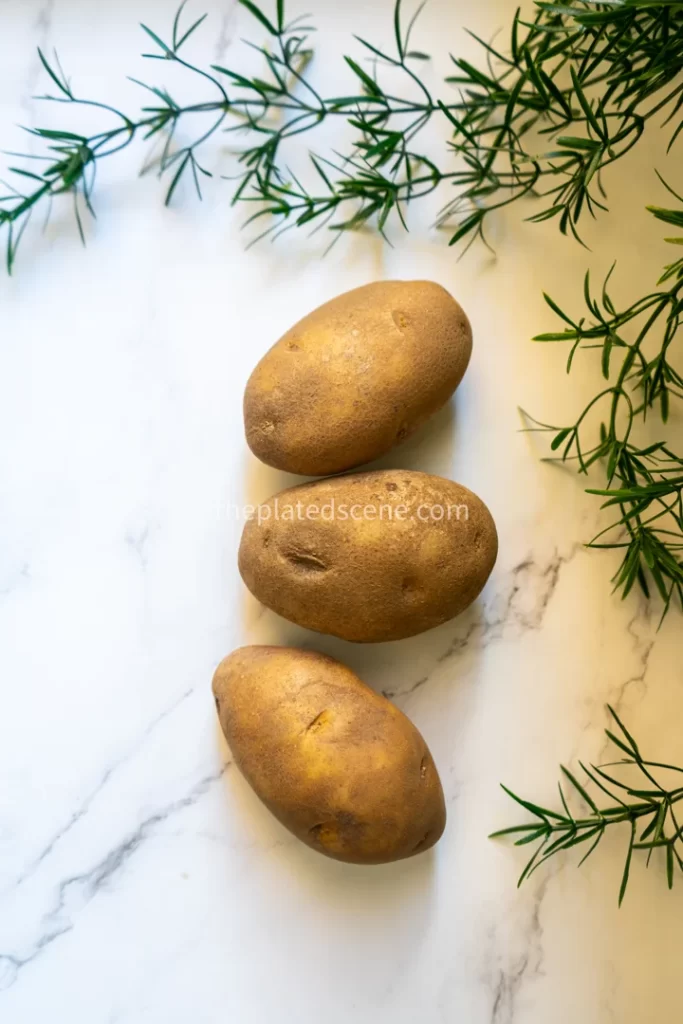
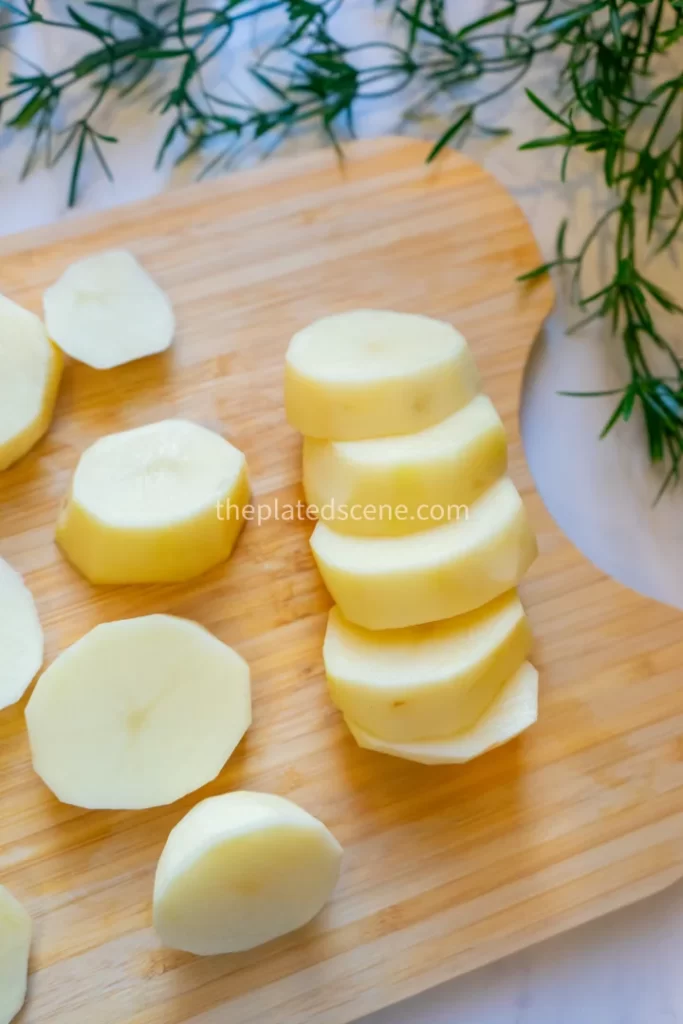
Best Potatoes for Perkedel Kentang:
- Starchy Potatoes (Russet or Yukon Gold): These are ideal for perkedel kentang because their low moisture content creates a fluffy, creamy texture when mashed. Starchy potatoes also hold their shape better during frying.
- Waxy Potatoes (Red or New Potatoes): These are less suitable as they have higher water content, making the mixture too wet. However, you can still use them by frying or roasting them before mashing them to reduce moisture.
Preparing Potatoes for Perkedel Kentang:
- Frying vs. Boiling: Frying the potatoes adds a depth of flavor and removes excess moisture, resulting in a firmer, more flavorful mixture. Alternatively, roast the potatoes in the oven until golden and tender for a healthier option.
- Mashing: Mash the potatoes until smooth, but avoid overworking them, as this can make the texture gummy. For a rustic feel, leave small chunks of potato in the mash.
2. Aromatics: Garlic and Shallots
Garlic and shallots are the aromatic backbone of perkedel kentang, providing a savory and slightly sweet flavor that complements the potatoes beautifully.
Why Use Blended Garlic and Shallots?
Blending garlic and shallots ensures an even distribution of flavor throughout the mixture. The smooth consistency of the blend eliminates any overpowering chunks, allowing the aromatics to infuse into every bite.
Preparation Tips:
- Lightly fry the garlic and shallots before blending to mellow their sharpness and enhance their natural sweetness.
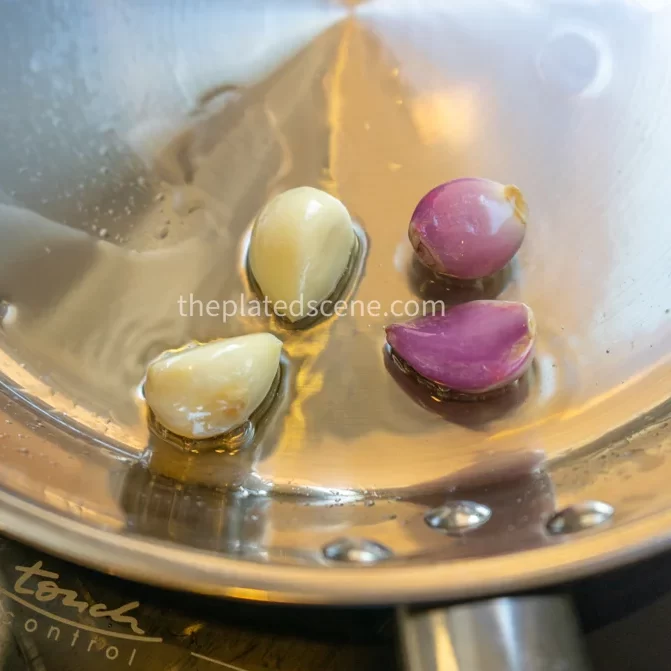
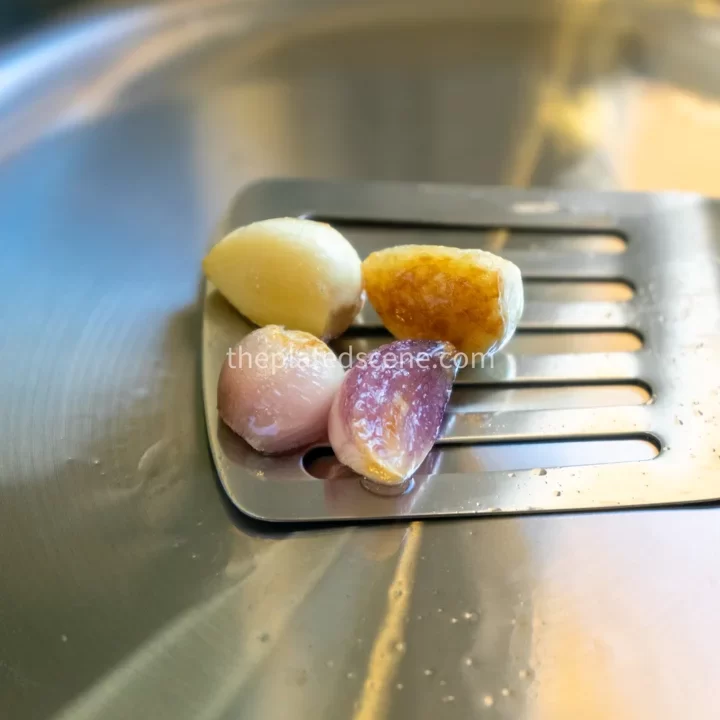
- If you prefer a more robust flavor, use them raw in the mixture.
Substitutes:
- Onions: In the absence of shallots, finely chopped onions can be used, though they may be slightly less sweet.
- Leeks: Leeks provide a mild onion-like flavor and can add an interesting twist to traditional perkedel kentang.
3. Green Onion: A Fresh Finish
Chopped green onion adds freshness and a subtle sharpness to the otherwise rich and creamy perkedel kentang.
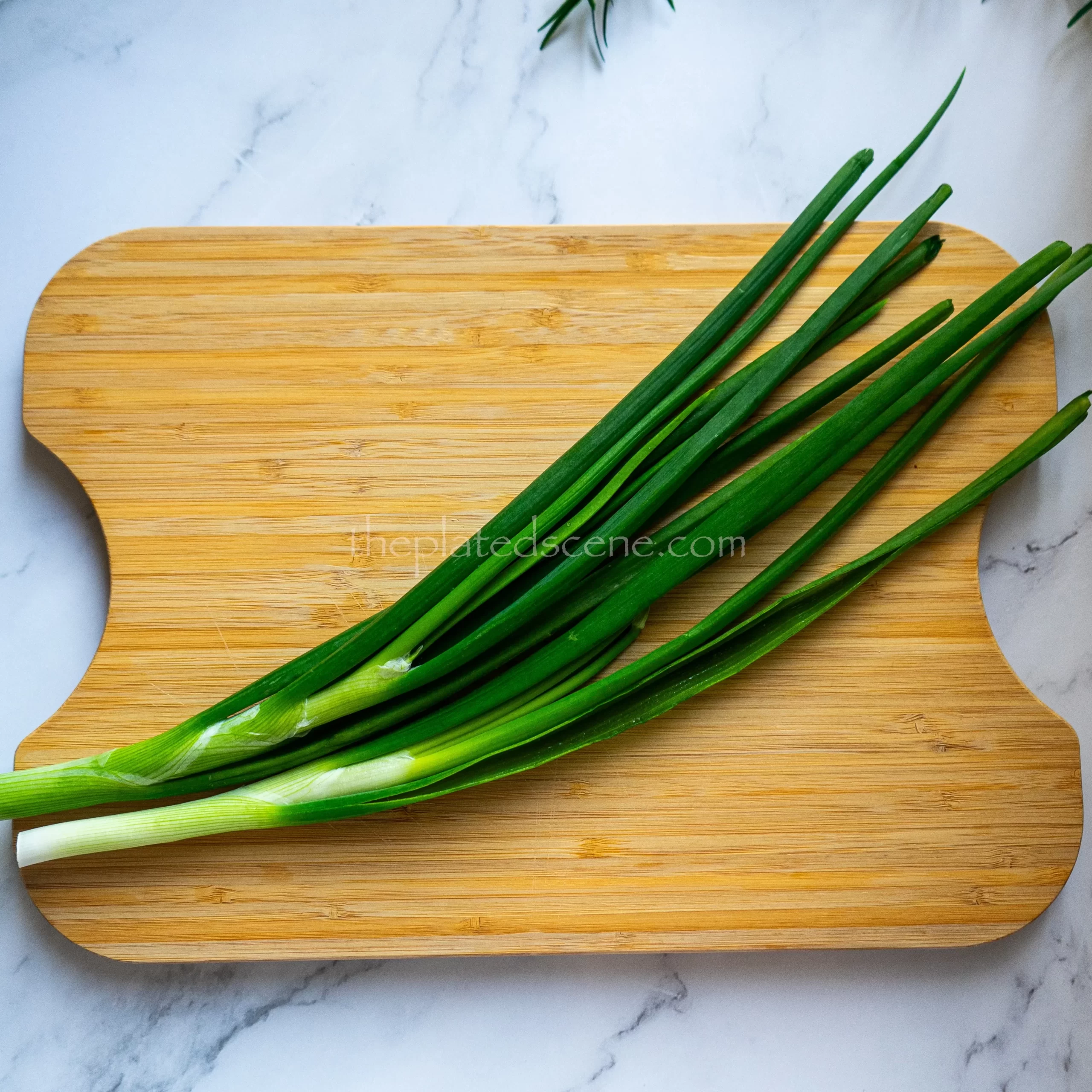
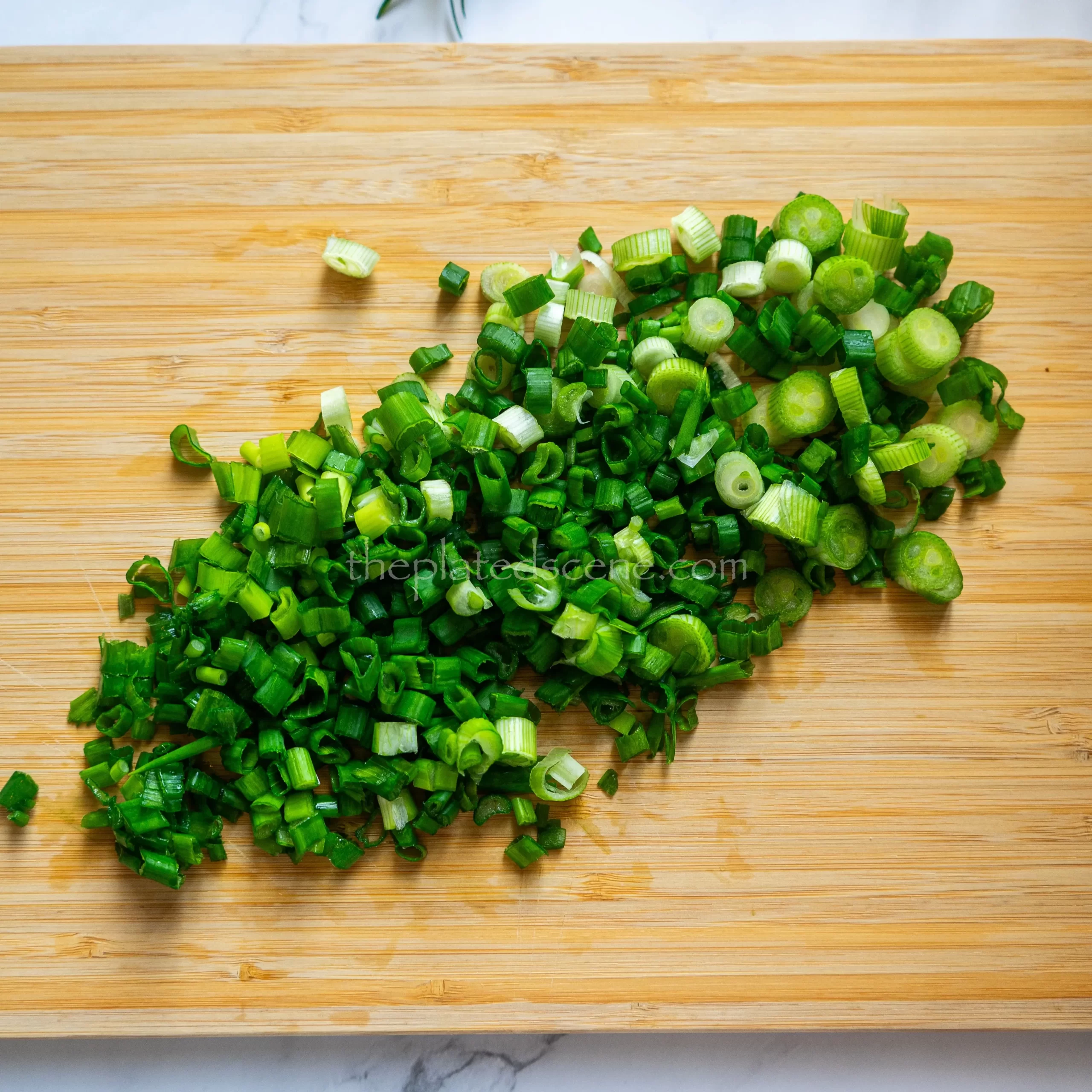
Tips for Using Green Onions:
- Use only the green parts for a milder flavor or include the white parts for a more decisive onion kick.
- Chop the green onions finely to ensure they mix well into the potato mixture.
Variations:
- Celery Leaves: Finely chopped celery leaves are used instead of green onions in some traditional recipes, adding a slightly bitter and aromatic note.
- Parsley: For a Western twist, finely chopped parsley can be added for a herbaceous flavor.
4. Mushroom Stock: A Vegan-Friendly Umami Boost
Mushroom stock is a fantastic addition to perkedel kentang, especially for vegan recipes. It adds a rich, savory depth of flavor that mimics the umami of meat-based broths.
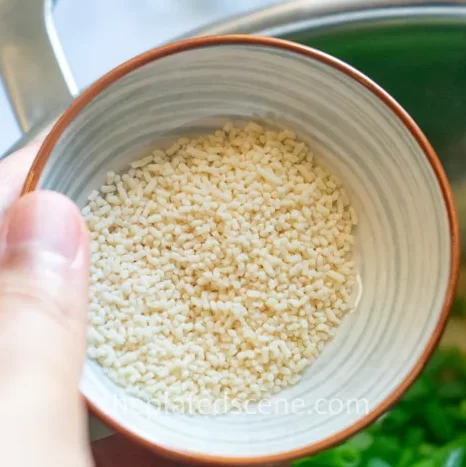
How to Use Mushroom Stock:
- Dissolve a small amount of mushroom stock powder or paste into the mashed potatoes for even distribution.
- Avoid adding too much liquid to prevent the mixture from becoming overly wet.
Alternatives:
- Vegetable Stock: If mushroom stock isn’t available, use vegetable stock as a substitute. Reduce the amount to avoid excess moisture.
- Soy Sauce: A few drops of soy sauce can also add umami, but be cautious with the salt level.
5. Binding Agents: Egg or Vegan Alternatives
A binding agent is crucial for holding the potato mixture together and creating a smooth, cohesive patty.
Traditional Option:
- Egg: The most common binding agent, egg also forms a thin coating on the outside of the patties, giving them a golden crust during frying.
Vegan Alternatives:
- Cornstarch: Mix 1-2 tablespoons into the potato mixture for a firm texture.
- Flaxseed Mixture: Combine one tablespoon of ground flaxseed with 2.5 tablespoons of water to create a gel-like consistency.
- All-Purpose Flour: A simple and effective option that binds the mixture without altering the flavor.
6. Cooking Oil: For Frying Perkedel Kentang
The type of oil you use can affect both the flavor and the frying process of perkedel kentang.
Best Oils for Frying:
- Neutral Oils: Use oils with a high smoke point, such as vegetable oil, canola oil, or sunflower oil, to ensure even frying without imparting a strong flavor.
- Coconut Oil: For a hint of tropical aroma, coconut oil is a unique alternative but may slightly alter the flavor.
Frying Tips:
- Use enough oil to submerge the patties or cover at least halfway for even cooking.
- Maintain the oil temperature at medium heat (170-180°C or 340-360°F) to prevent soggy or overly greasy patties.
7. Optional Add-Ins: Meat, Tofu, or Corn
While traditional perkedel kentang focuses on potatoes, many variations incorporate additional ingredients to enhance flavor and texture.
Popular Add-Ins:
- Minced Meat: Ground beef or chicken adds a hearty, protein-packed twist.
- Tofu: Crumbled tofu is a great vegan option that adds a creamy texture.
- Corn Kernels: Mix in some corn kernels for a sweet and crunchy variation.
Tips for Adding Ingredients:
- Ensure any add-ins are finely chopped or crumbled to blend seamlessly into the mixture.
- Pre-cook meats or other raw ingredients before mixing to ensure they are fully cooked.
Step-by-Step Instructions to Make Perfect Perkedel Kentang
Making perkedel kentang might seem simple, but each step plays a vital role in achieving the perfect texture, flavor, and appearance. Below, I’ll provide a comprehensive guide to every stage of the process, with detailed tips and tricks to ensure your perkedel kentang turns out delicious and perfectly crispy every time.
1. Prepare the Potatoes
Fry or Roast the Potatoes
Traditional recipes often fry the potatoes instead of boiling them to remove moisture and add a rich, caramelized flavor. Here’s how:
- Frying Method:
- Peel and cut the potatoes into small chunks for even cooking.
- Heat oil in a pan over medium heat.
- Fry the potato chunks until they are golden brown and tender when pierced with a fork. Be careful not to burn them.
- Remove the potatoes from the oil and drain on paper towels to remove excess grease.
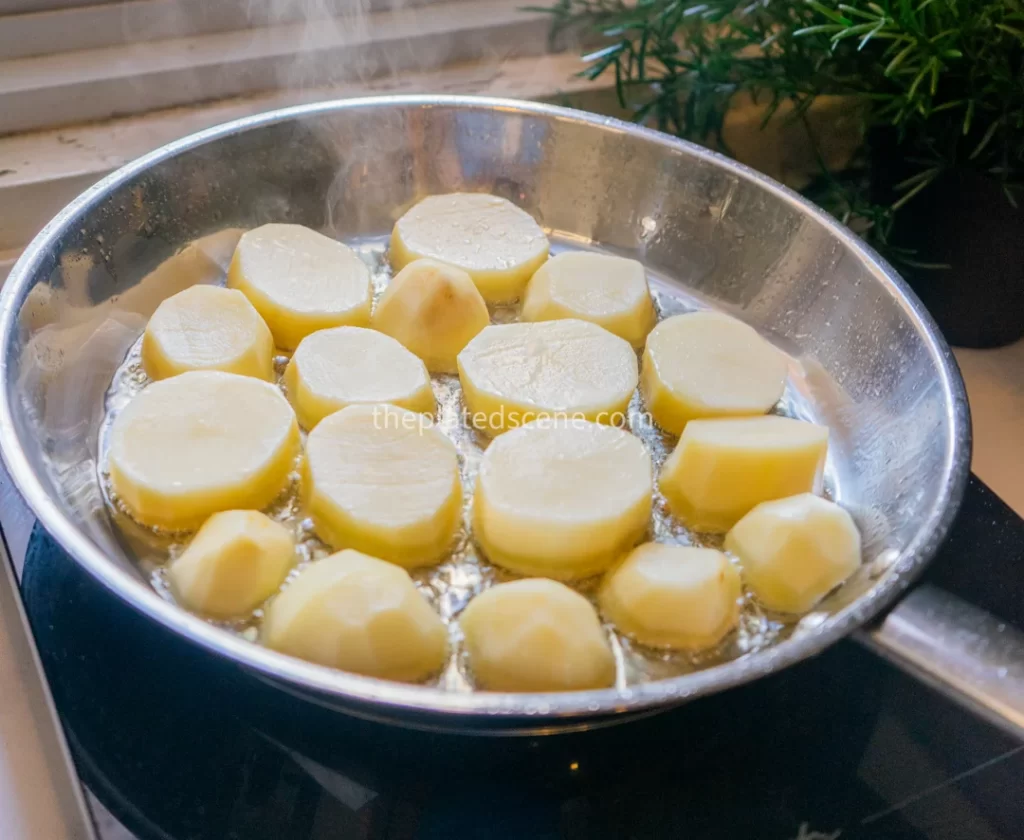
- Roasting Method (a healthier alternative):
- Preheat your oven to 200°C (400°F).
- Place peeled and cubed potatoes on a baking tray, drizzle with a small amount of oil, and toss to coat evenly.
- Roast for 30-40 minutes, turning halfway through, until the potatoes are soft and golden.
2. Mash the Potatoes
Once the potatoes are cooked, let them cool slightly for easier handling. There are two effective methods for mashing your potatoes based on the tools available:
Method 1: Using an Immersion Blender (Masher Attachment)
- Attach the masher tool to your immersion blender (here is the one I use).
- Gently mash the potatoes in a large mixing bowl, moving the blender evenly across the bowl for consistent results.
- Avoid over-mashing, as this can lead to a gummy texture. For a more rustic feel, leave small chunks for added texture.
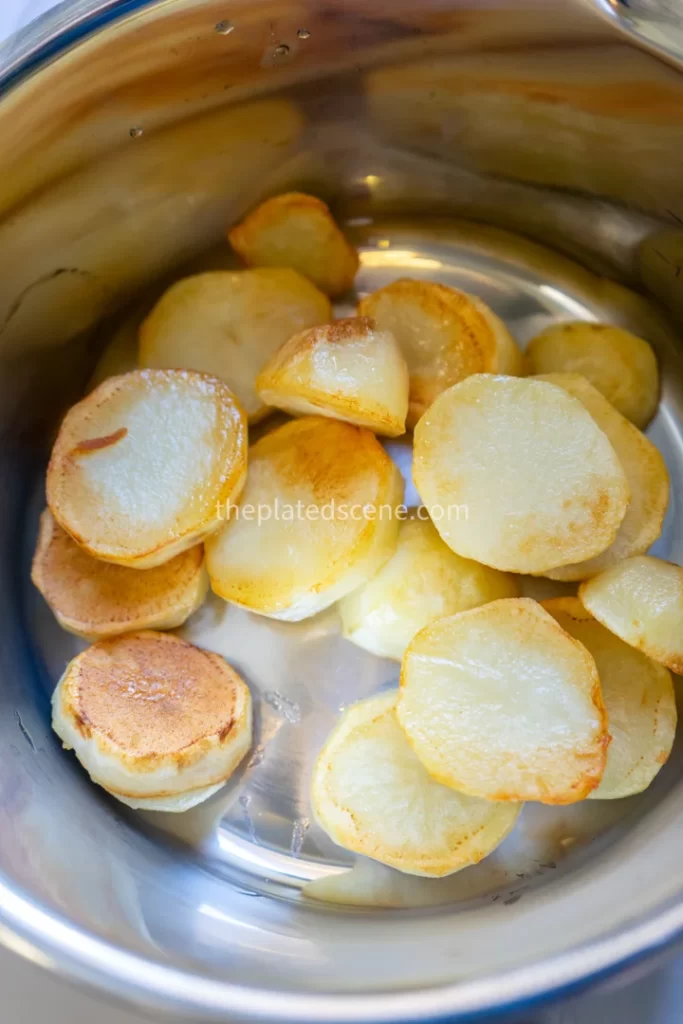
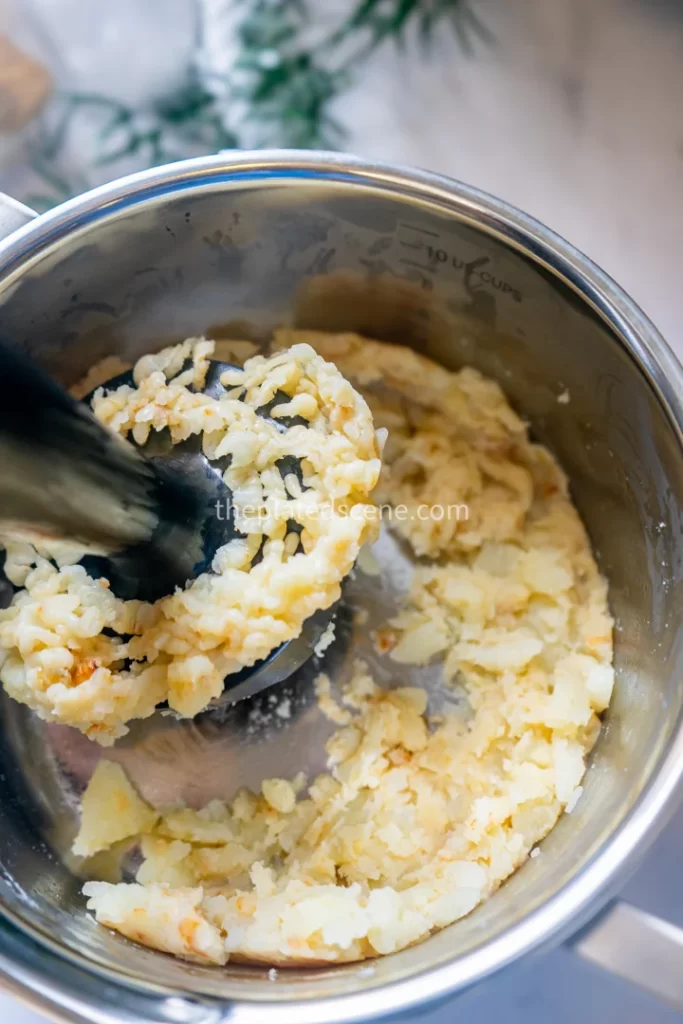
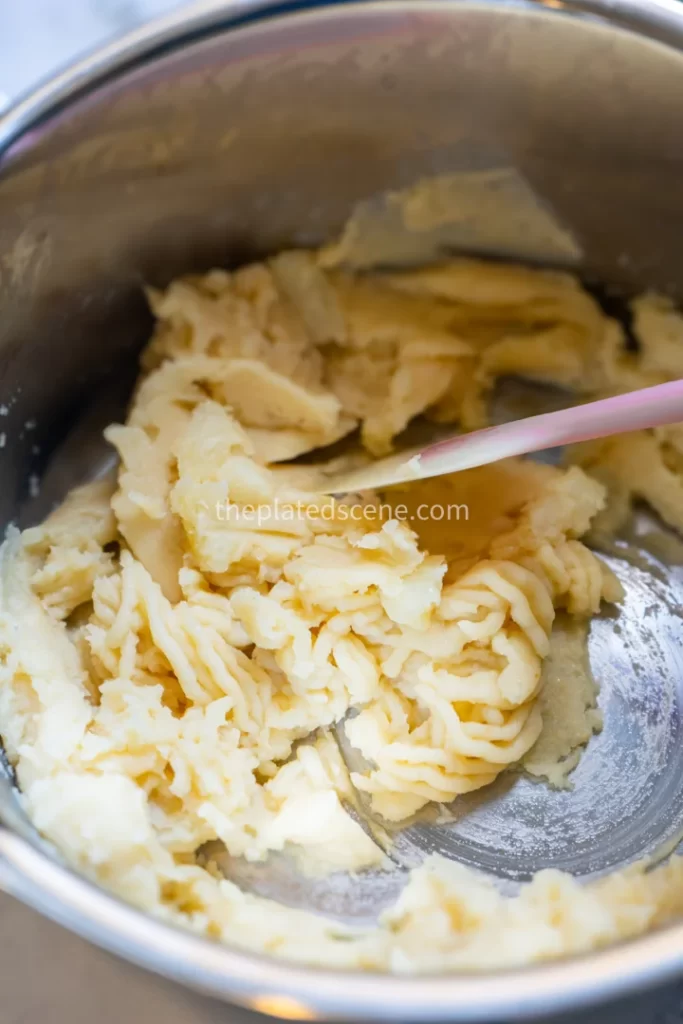
Method 2: Using a Potato Masher or Fork
- Place the potatoes in a large mixing bowl.
- Use a handheld potato masher or a sturdy fork to mash the potatoes until smooth.
- This method gives you more control over the texture, keeping the mash as smooth or chunky as you like.
- Ensure there are no large lumps, as these could make shaping the patties uneven.
Choose the method that works best for you based on the tools you have available. Both methods will result in a perfectly mashed base for your perkedel kentang.
3. Prepare the Aromatics
Blending Garlic and Shallots
Aromatics like garlic and shallots are the foundation of flavor for perkedel kentang. Here’s how to prepare them:
- Peel the garlic and shallots and chop them into smaller pieces for more effortless blending.
- Lightly fry the garlic and shallots in a bit of oil until fragrant. This mellows their sharpness and enhances their natural sweetness.
- Blend or finely mince the fried aromatics until smooth.
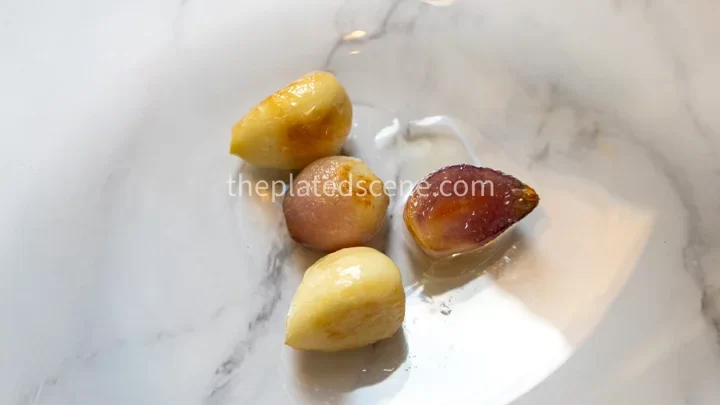
Mixing with the Potatoes
- Add the blended garlic and shallots to the mashed potatoes.
- Mix thoroughly to ensure the aromatics are evenly distributed throughout the potato mixture.
4. Add Ingredients and Mix Thoroughly
This step combines all the flavor-enhancing and binding ingredients to create a cohesive mixture for your perkedel kentang. Here’s how:
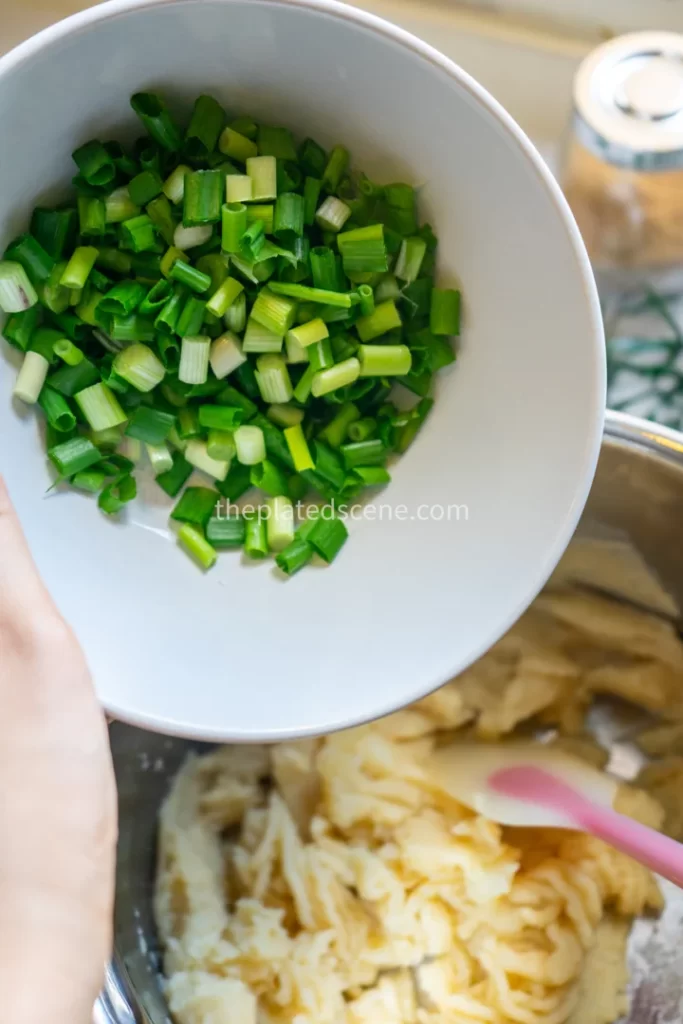
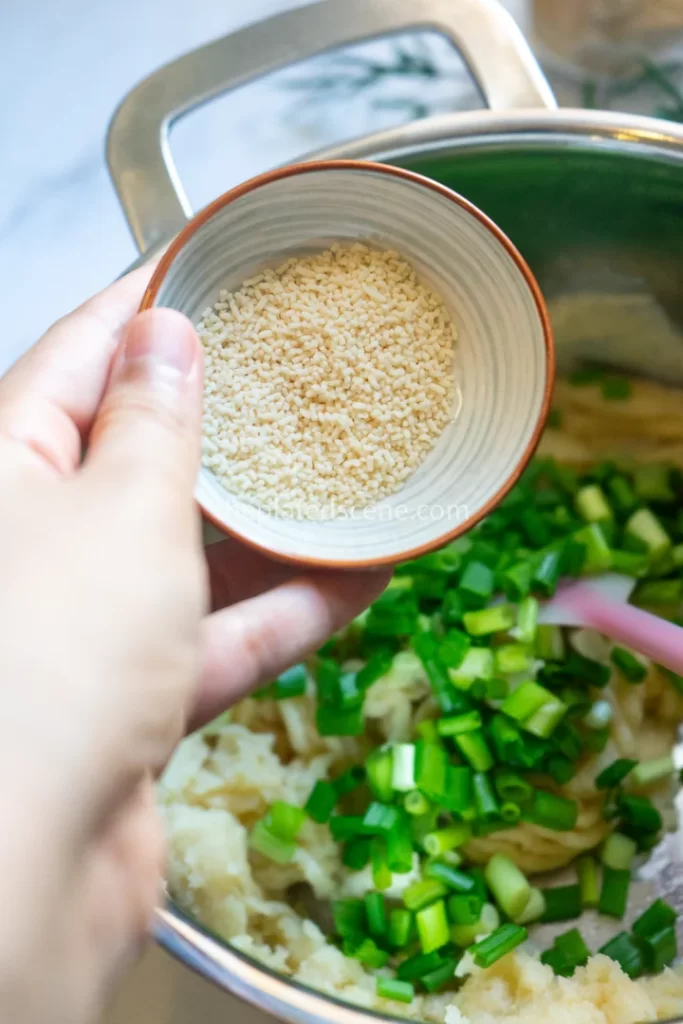
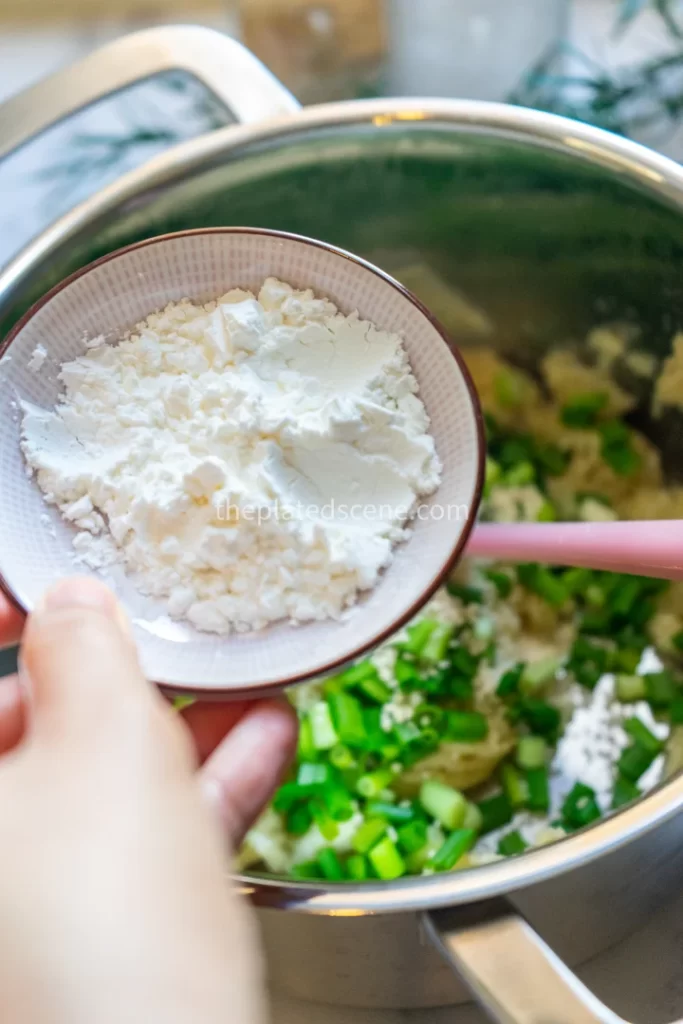
- Add cornstarch to the mashed potato mixture as a binding agent.
- Add mushroom stock granules to enhance the umami flavor.
- Add chopped spring onions for a fresh and aromatic touch.
- Mix everything thoroughly until the ingredients are evenly distributed and the cornstarch is fully incorporated. The mixture should feel firm and hold its shape when pressed.
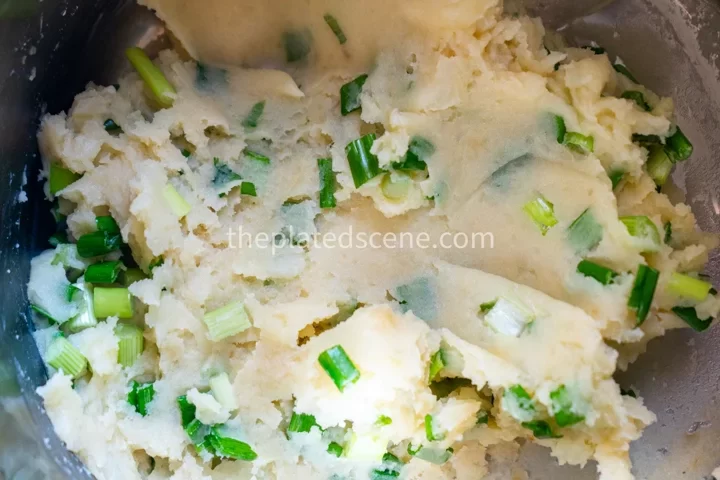
5. Shape the Patties
Once the potato mixture is well-seasoned and bound, it’s time to shape the patties.
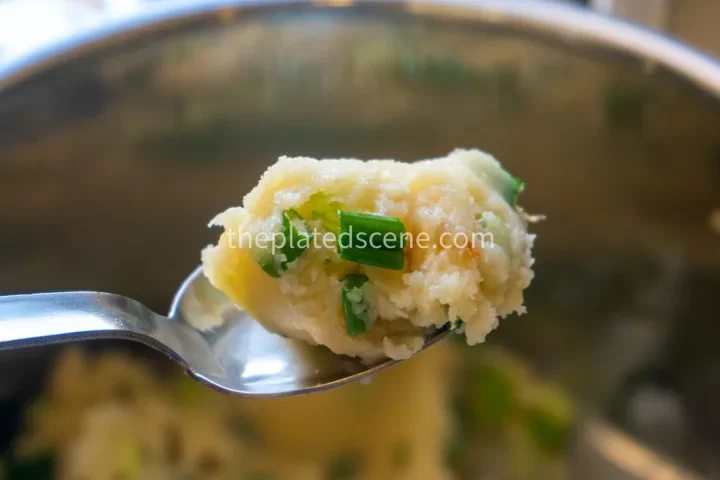
- Scoop about two tablespoons of the mixture for each patty. You can use an ice cream scoop for uniform sizes.
- Roll the mixture into a ball using your hands, then flatten it slightly to form a disc.
- Place the shaped patties on a tray lined with parchment paper.
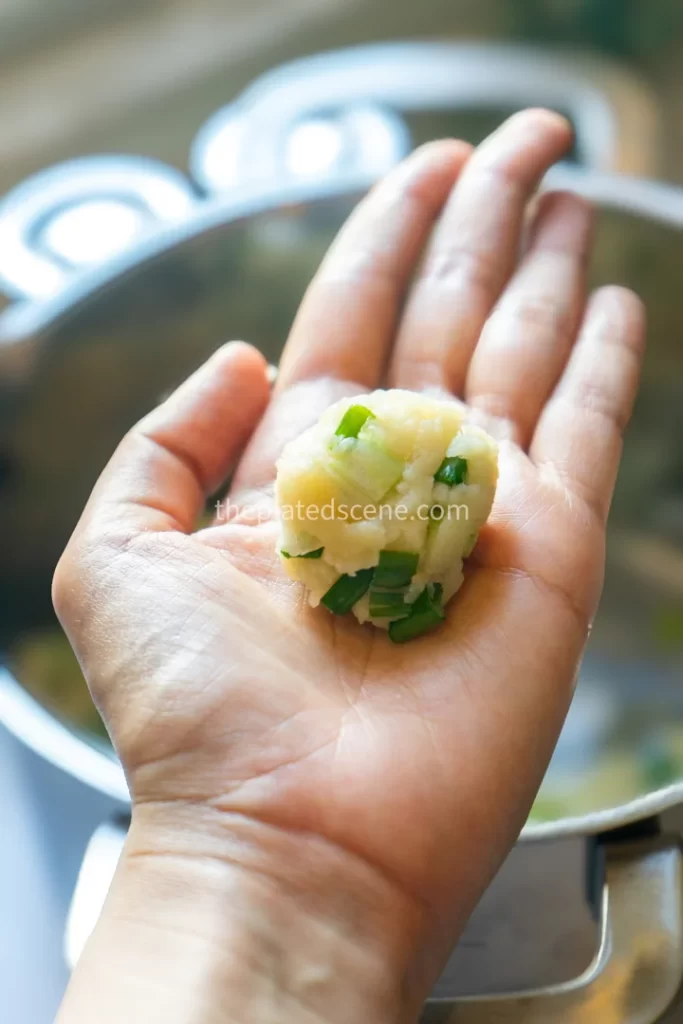
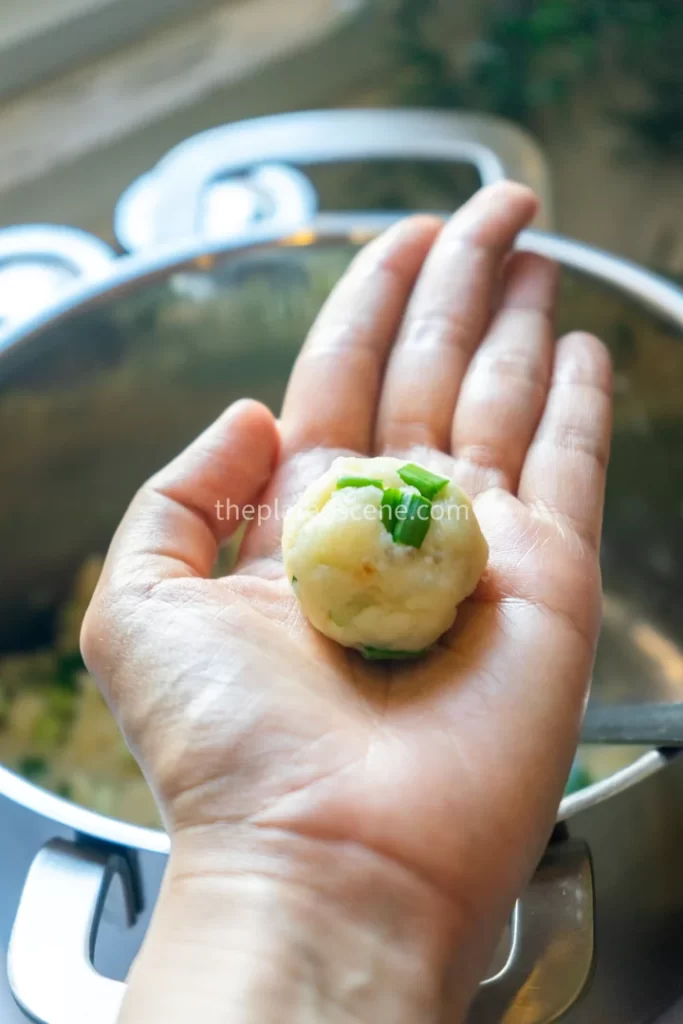
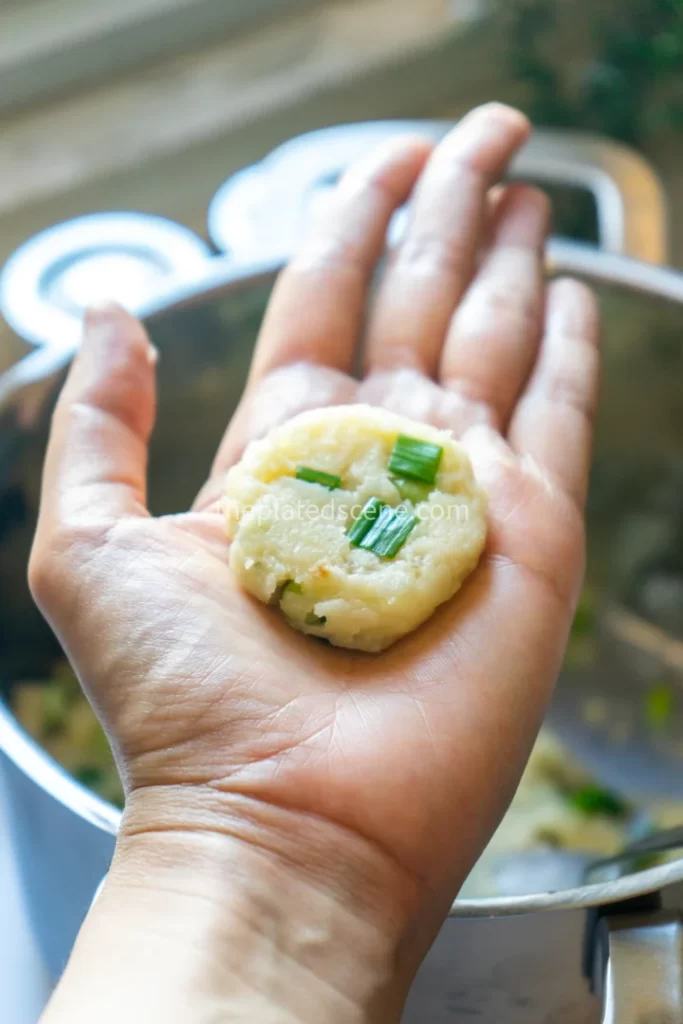
Pro Tip:
Refrigerate the patties for 30 minutes to firm them up. This step is essential when using cornstarch, as it helps the patties hold their shape better during frying.
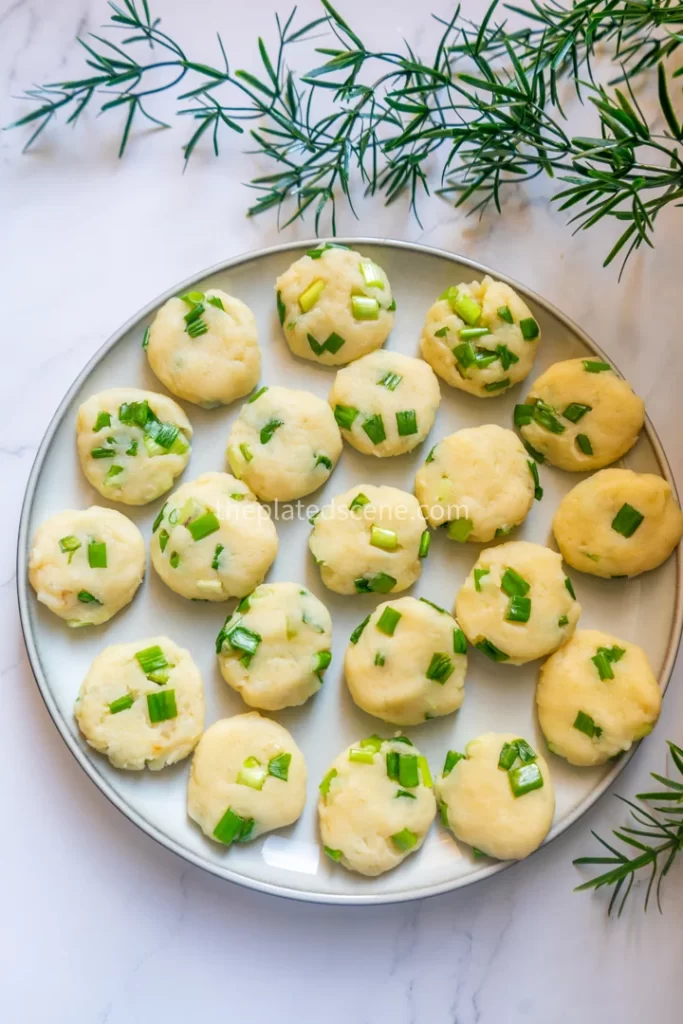
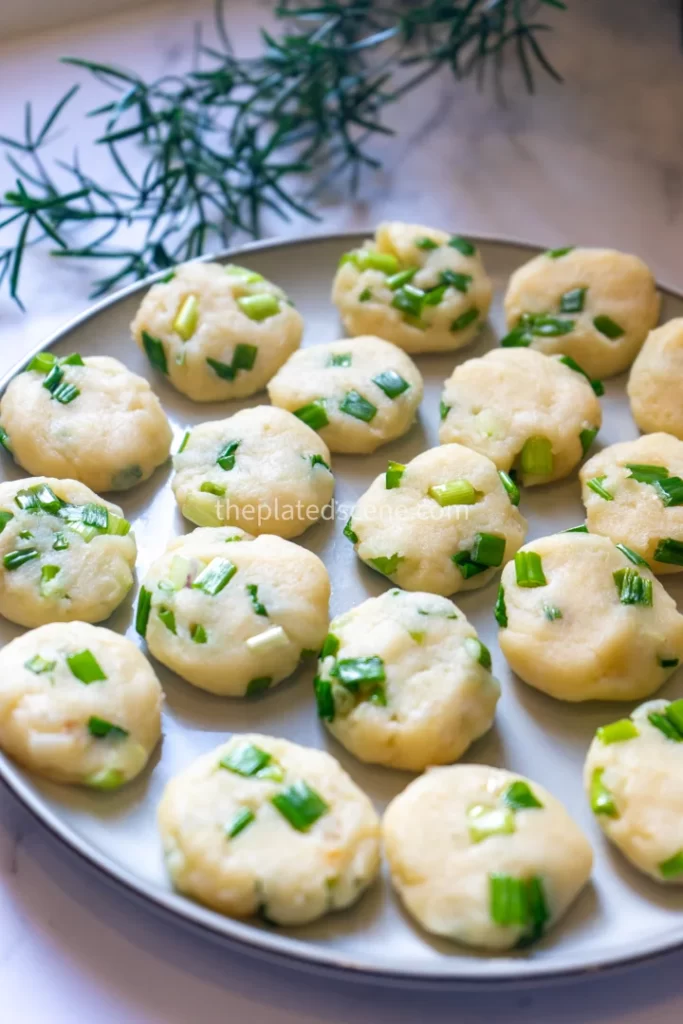
6. Fry the Perkedel Kentang
The frying process is critical to achieving a golden, crispy exterior while keeping the inside soft and creamy. Follow these steps:
Heat the Oil
- Use a neutral oil with a high smoke point, such as vegetable or canola.
- Heat the oil in a deep pan or wok over medium heat. The oil should be hot enough that a breadcrumb dropped into it sizzles immediately (about 170-180°C or 340-360°F).
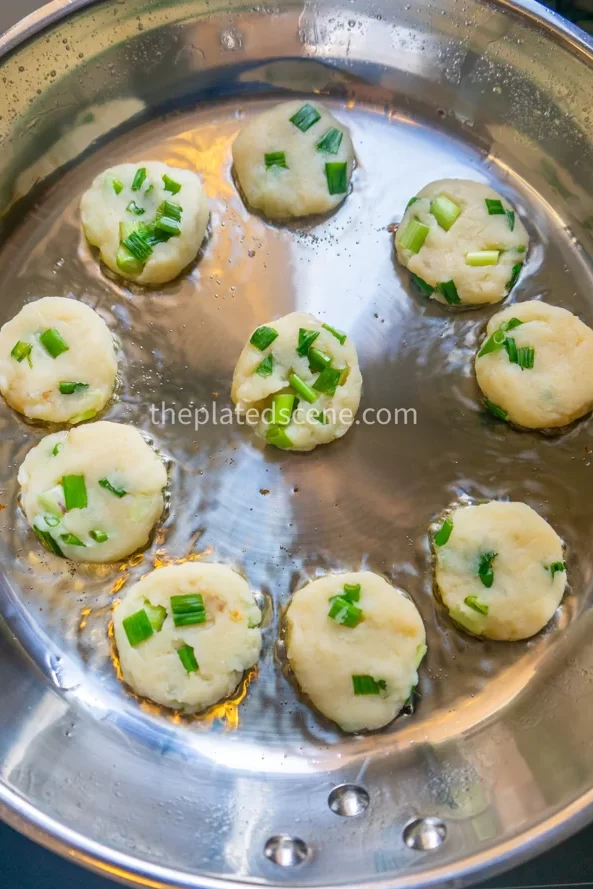
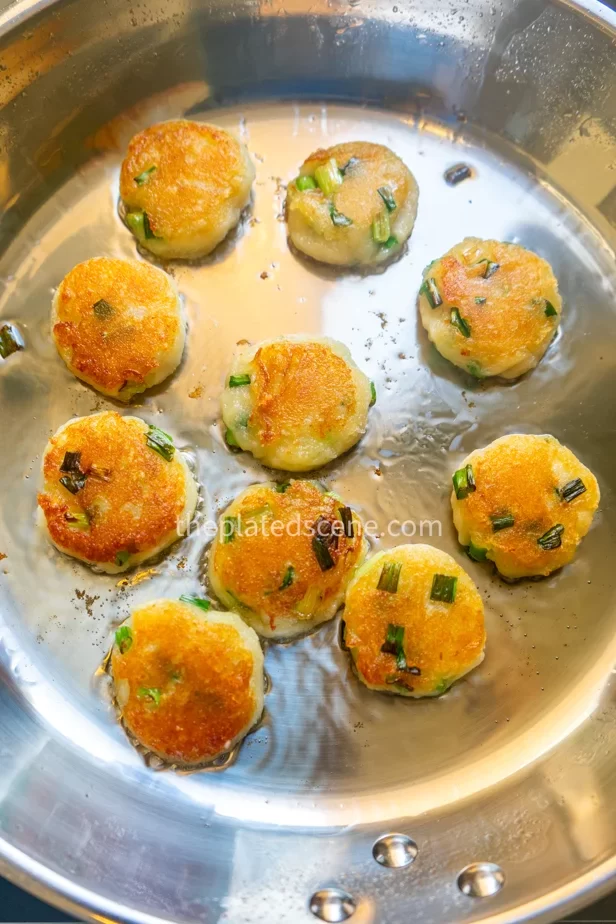
Fry in Batches
- Gently slide the patties into the hot oil using a spatula. Avoid overcrowding the pan, which can lower the oil temperature and result in soggy fritters.
- Fry each patty for 2-3 minutes per side or until golden brown and crispy.
- Use a slotted spoon to remove the patties from the oil and place them on a wire rack or paper towel to drain excess oil.
Pro Tip:
Let the patties cook undisturbed for the first minute before flipping to prevent them from breaking apart.
7. Serve and Enjoy
Perkedel kentang is best enjoyed fresh and hot, but it can also be served at room temperature. Here’s how to serve it:
- As a side dish: Pair with soto ayam, rendang, or nasi kuning.
- As a snack: Serve with sambal or a simple dipping sauce made from soy sauce, lime juice, and chopped chilies.
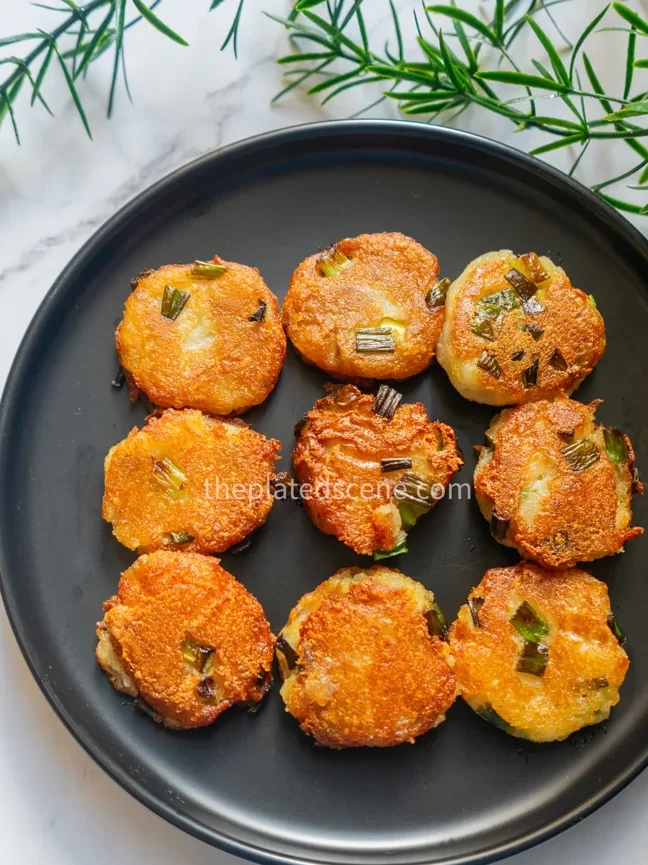
Common Mistakes to Avoid
Even experienced cooks can encounter issues when making perkedel kentang. Here are some common mistakes and how to avoid them:
- Too Wet Mixture: Always fry or roast the potatoes to reduce moisture. Avoid adding too much liquid seasoning.
- Breaking Apart During Frying: Ensure the mixture is firm by chilling the patties and using an adequate binding agent.
- Underseasoning: Always taste the potato mixture before frying. A well-seasoned base is crucial for flavorful perkedel kentang.
- Greasy Fritters: Maintain the oil temperature to prevent the patties from soaking up excess oil.
Why Perkedel Kentang is a Beloved Dish
Perkedel kentang is more than just a side dish; it represents Indonesian comfort food at its finest. Its simplicity, versatility, and rich flavors make it a favorite for everyday meals and special occasions. Whether served with soup or rice or enjoyed as a standalone snack, perkedel kentang is a dish that brings joy with every bite.
Pairing Suggestions for Perkedel Kentang
Perkedel kentang is a versatile dish that pairs wonderfully with Indonesian soups and curries. Here are some delicious pairing suggestions to create a complete and satisfying meal:
- Gulai Nangka
The rich and creamy flavors of Gulai Nangka (young jackfruit curry) perfectly complement the crispy texture of perkedel kentang. The spicy coconut-based curry adds a depth of flavor that enhances the potato fritters.
👉 Try the recipe for Gulai Nangka here - Vegan Chicken Soup
Enjoy perkedel kentang with a comforting bowl of Vegan Chicken Soup for a lighter pairing. The warm, herby broth and vegetables balance the savory fritters, making it a hearty yet wholesome combination.
👉 Check out the Vegan Chicken Soup recipe here - Sayur Bening Bayam
Pair your perkedel kentang with Sayur Bening Bayam (clear spinach soup) if you prefer something refreshing. The light and healthy soup, with its mild flavors of spinach and garlic, perfectly contrasts the fritters’ richness.
👉 Learn how to make Sayur Bening Bayam here
Try Making Perkedel Kentang Today!
With these tips and tricks, you can create the perfect perkedel kentang in your kitchen. Whether you stick to the classic recipe or experiment with new variations, you’ll discover why this humble potato fritter is a beloved part of Indonesian cuisine. Happy cooking!


